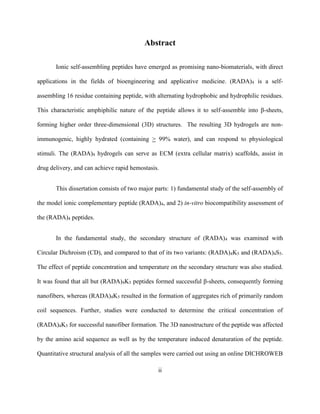Abstract_Dissertation
This document summarizes a dissertation that studied the self-assembly and biocompatibility of ionic self-assembling peptides. The dissertation consisted of studying the fundamental self-assembly properties of the peptide (RADA)4 and variants, as well as in-vitro biocompatibility assessments. Circular dichroism, fluorescence correlation spectroscopy, differential scanning calorimetry, and microscopy techniques were used to examine the secondary structure, molecular interactions, hydration effects, and nanostructures formed by the peptides. Platelet activation, complement activation, clotting analysis, and platelet morphology were also evaluated to assess the biocompatibility of the peptides, finding that while they activated platelets and complement, the activation was

Recommended
Recommended
More Related Content
What's hot
What's hot (18)
Similar to Abstract_Dissertation
Similar to Abstract_Dissertation (20)
Abstract_Dissertation
- 1. ii Abstract Ionic self-assembling peptides have emerged as promising nano-biomaterials, with direct applications in the fields of bioengineering and applicative medicine. (RADA)4 is a self- assembling 16 residue containing peptide, with alternating hydrophobic and hydrophilic residues. This characteristic amphiphilic nature of the peptide allows it to self-assemble into β-sheets, forming higher order three-dimensional (3D) structures. The resulting 3D hydrogels are non- immunogenic, highly hydrated (containing > 99% water), and can respond to physiological stimuli. The (RADA)4 hydrogels can serve as ECM (extra cellular matrix) scaffolds, assist in drug delivery, and can achieve rapid hemostasis. This dissertation consists of two major parts: 1) fundamental study of the self-assembly of the model ionic complementary peptide (RADA)4, and 2) in-vitro biocompatibility assessment of the (RADA)4 peptides. In the fundamental study, the secondary structure of (RADA)4 was examined with Circular Dichroism (CD), and compared to that of its two variants: (RADA)4K5 and (RADA)4S5. The effect of peptide concentration and temperature on the secondary structure was also studied. It was found that all but (RADA)4K5 peptides formed successful β-sheets, consequently forming nanofibers, whereas (RADA)4K5 resulted in the formation of aggregates rich of primarily random coil sequences. Further, studies were conducted to determine the critical concentration of (RADA)4K5 for successful nanofiber formation. The 3D nanostructure of the peptide was affected by the amino acid sequence as well as by the temperature induced denaturation of the peptide. Quantitative structural analysis of all the samples were carried out using an online DICHROWEB
- 2. iii server, by comparing the secondary structure molar ellipticity of the peptides collected with that of seven reference proteins (data confirmed via X-ray crystallography). Single-molecule Florescence Correlation Spectroscopy (FCS) was used to confirm the molecular interaction of the pristine (RADA)4 nanofibers with 25% (RADA)4K5. The effect of hydration on these self-assembling peptides was investigated via Differential Scanning Calorimetry (DSC), over a range of temperatures. The Equilibrium Water Content (EWC) in (RADA)4 was comparable to (RADA)4S5 and (RADA)4K5, even at varying compositions. The content of non-frozen bound water increased upon appending either Lysine or Serine residues to the (RADA)4 peptide. Microscopy techniques such as Atomic Force Microscopy (AFM), and Transmission Electron Microscopy (TEM), were also employed to visually inspect the higher order structures formed by these peptides. The second part of this dissertation focuses on the in-vitro biocompatibility of the (RADA)4 based peptides. The PAC-1, CD62-P, and CD42 markers were used to study platelet activation (via Flow Cytometry) and a time based clotting analysis was conducted to evaluate the hemostatic ability of peptides. Complement C3a ELISA assay was conducted with (RADA)4 based peptides to gain more insight into the biocompatibility. The pristine (RADA)4 nanofibers caused a rapid clot formation, but yielded a low platelet activation and low C3a activation. Whereas, (RADA)4K5 peptide displayed a significantly higher complement activation, when compared to both (RADA)4S5, and the (RADA)4 peptide, likely due to the free NH3 groups and steric hindrance in packing. The overall trend of the platelet activation among the three variants of the peptides remained consistent: (RADA)4K5 activated the platelets to the highest, whereas (RADA)4S5, and (RADA)4 showed comparable platelet activation. However, it should be noted
- 3. iv that both the platelet and complement activation by these peptides were lower than the already considered biocompatible biopolymers. Lastly, morphology analysis of the platelets in contact with the hydrogels was conducted by calculating the Morphology Score (MS) using a Kunicki scoring system, and the platelets were visualized using Scanning Electron Microscopy (SEM). An overall Kunicki morphology score of above 385 was achieved for all the peptides, where a score of less than 200 represent poor retention of morphological characteristics associated with platelets that are active. Overall, the (RADA)4 based peptides had a lower, or comparable platelet and complement activation, when compared with the already in-use biomaterials (such as poly(methyl methacrylate), and dextran), making them a desirable material to further investigate. The work in this dissertation, not only provides the fundamental knowledge to design novel biomaterials for direct application in medicine, but also provides the stepping stone for further in-vitro and in-vivo biocompatibility analysis, required for any further medical application.